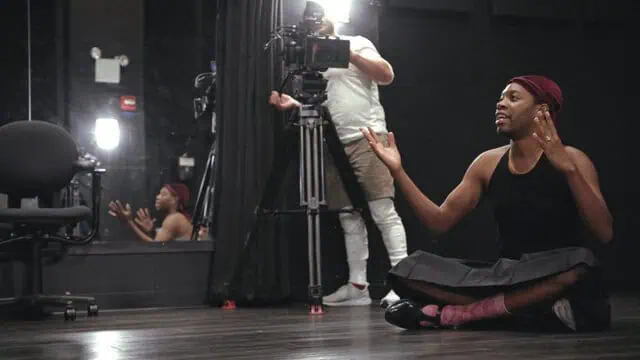
It was the mirrors that caught my attention. I hadn’t seen Jeremy O. Harris’ groundbreaking Slave Play, but Charles McNulty’s review in the Los Angeles Times heralding the West Coast premiere made me very curious. A stage with mirrors behind the actors, so the audience had no choice but to watch themselves while watching the actors on stage. That kind of self-reflexive recursion is like ice cream to me.
Slave Play. Not a Movie. A Play. takes those mirrors and aims them at each other in a way that could blissfully trap you in Harris’ 80-minute documentary forever. But is documentary the right word? Harris’ title isn’t just playful; it’s a guide. Using the same three-act structure of his play — Work, Process, Exercise — Harris uses multiple cameras to workshop the Tony Award-nominated Slave Play, capture the success surrounding it and then reconfigure all of that in the editing room.
It’s a radical work that feels like punk rock, Samuel Beckett, a Jean-Luc Godard essay film and a Kevin B. Lee desktop documentary wrapped around Harris’ commanding voice. As he tells a group of students, film everything because you never know what you’ll want to use.
Streaming on Max, Slave Play. Not a Movie. A Play. (hereafter Not a Movie) is probably the best chance audiences will get to see elements of Slave Play the stage show. As Harris tells his editor, Pete Ohs, in the doc: A play can be stopped, the audience can engage the actors and force them to respond — evident in Not a Movie’s opening scene. A movie really can’t. But a movie can reach a much broader audience than the stage ever could.
And here’s where Harris really has fun: A movie can engage subjectively with material in ways that would be herculean on stage. Yes, the content of Slave Play — following three interracial couples undergoing "Antebellum Sexual Performance Therapy" — is what triggered all those discourses about race and sexual relationships, but it was the how that made it notable. Those mirrors made people sit up and take notice. To get there, Harris relied on style and a radical bit of set dressing to reinvigorate one of the oldest art forms. If you were in the audience, you didn’t just see yourself in one or two or all of the characters; you saw yourself among them.
But movies, even the most pedestrian of them, do that all the time. Close-ups, point of view, subjective storytelling and unreliable narrators are just four tricks filmmakers employ to get audiences to empathize and identify with all the characters in a movie, from the protagonist to the antagonist to the clerk running the bodega down the street.
One of the pleasures of Not a Movie is watching Harris discover how easy it is to create and manipulate with a camera. One scene shows Harris and Ohs editing Not a Movie while simultaneously creating images for the movie. “A snake eating its own tail,” Harris says. “Ouroboros are very popular right now,” Ohls adds. You can almost see Harris’ mind come alive, and that’s just with one camera and two screens. Ever seen an Instagram reel of a baby trying chocolate cake for the first time? It’s kind of like that.
But what is Slave Play about, and why did it become a firebrand? Harris does such a good job as an on-camera presence and behind-the-scenes author in Not a Movie that anything I could add would be superfluous. The hook here is watching Harris at work — a brilliant mind in constant motion, constant revision, constant revelation. It’s like he’s inside his own hall of mirrors, discovering new ideas and hearing new rhythms within the same material. For some artists, that’s a place you don’t want to be. For Harris, it looks like a hell of a lot of fun.
ON SCREEN: Slave Play. Not a Movie. A Play. is available to stream on Max.
